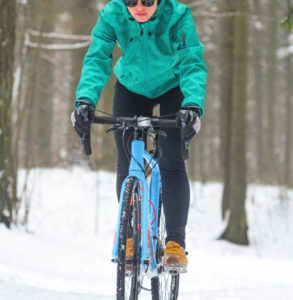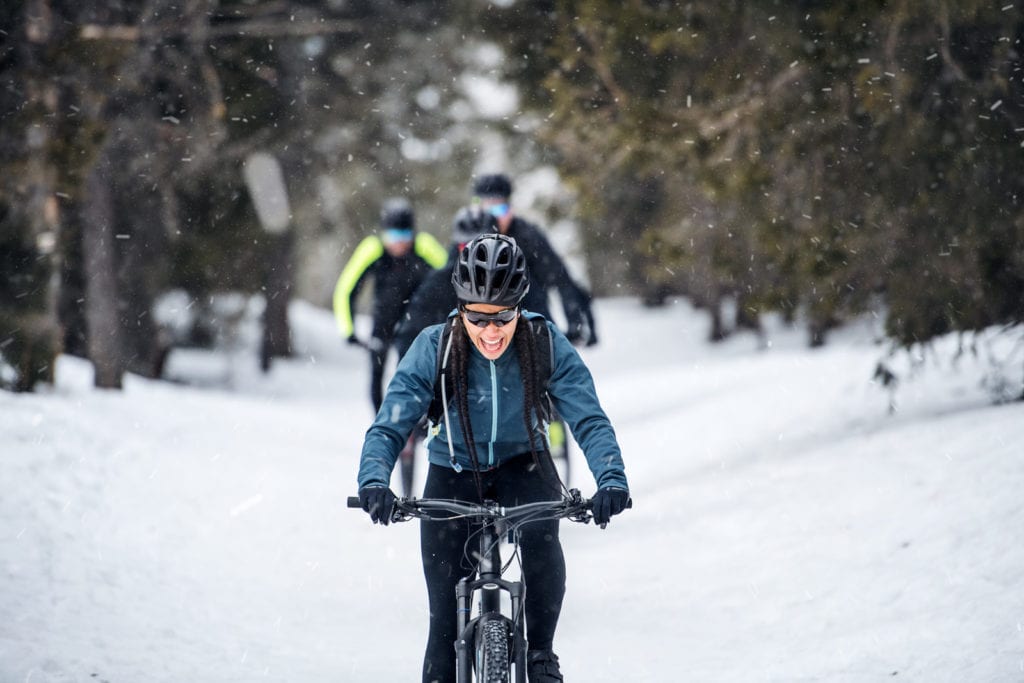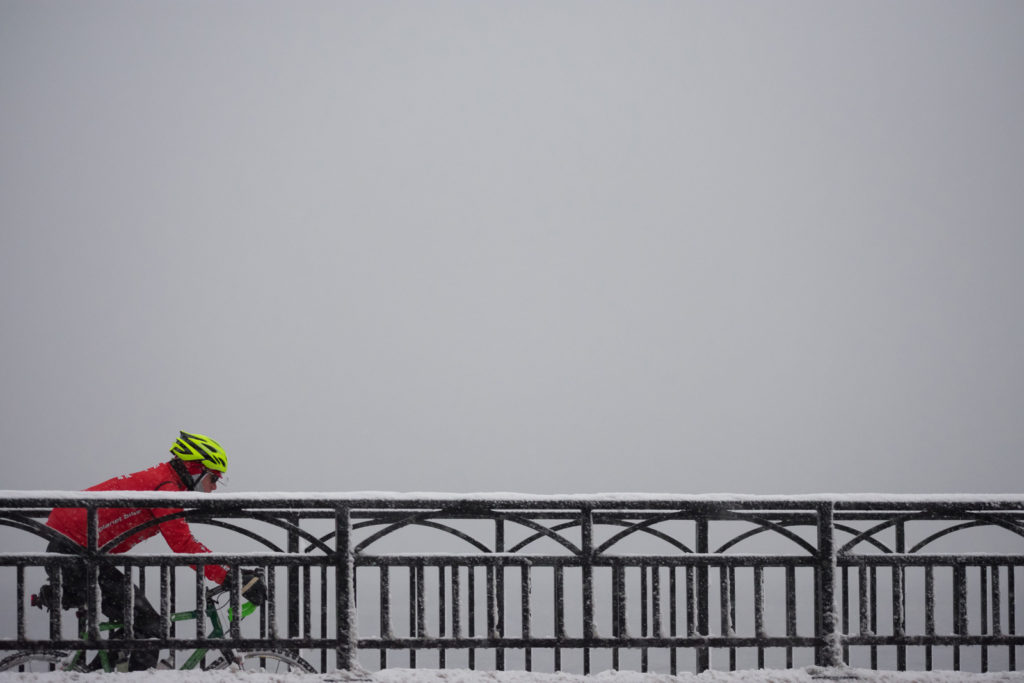Here is a roundup of winter cycling tips to help you stay warm, safe, and upright, through the deepest cold of the season.
More and more cyclists are choosing to keep riding through the winter, thanks to better equipment, clothing, and a little know-how.
Good snow clearance on the bike lanes of cycling-friendly cities helps a lot too, but even without that you don’t have to stop racking up the miles, or take to a car, just because it turns cold.
In fact, winter riding can be really fun – there’s great satisfaction in defying the cold to enjoy the outdoors and stay fit.
Some of my favorite early cycling memories are from long winter rides with my club mates, “twiddling” low fixed gears over hill and dale, picking our way gingerly over icy rural roads in frosted landscapes. The reward was always multiple pots of tea and toasted buns in our café of choice.
On the other hand, winter brings some real hazards – some fairly obvious, some not so much – that call for a little preparation and common sense.
The first key to enjoyable winter cycling: stay warm and dry.
As impoverished teens, my friends and I would start our early morning winter rides with newspapers lining our bike jerseys – it had some insulation value but the real benefit was wind-proofing. As both the day and the ride warmed up we would pull the papers out and discard them. Thankfully there are now much better options available (thank you, Terry).
- Choose your clothing with layering in mind, and go for fabrics with good moisture transport. Plan on adding or subtracting layers to suit the conditions as you go. A good baselayer, midlayer and a breathable windproof shell will take you comfortably through a wide range of conditions. It’s not a bad idea to bring an extra mid-weight layer just in case you end up waiting around somewhere in the cold (fixing a flat, for example), and a spare base layer in a water proof bag can feel like a life saver if you get soaked along the way. Experience talking there.
- Remember you will warm up as you work, so when you are first setting off it’s okay to feel slightly under-dressed. You will soon warm up, and if you felt warm to begin with you’d quickly overheat and get sweaty.
- Your core temperature is vital of course, but your extremities make a huge difference to your comfort, so it’s well worth kitting out with wind and waterproof gloves, and booties.
- Keeping your head warm is essential for keeping your core warm. Avoid jacket hoods, which fill with cold air as you ride. Instead opt for a tight fitting helmet liner or beanie, and a helmet cover to keep the wind off.
- Keep a quick source of heat on hand – air activated hand warmers slipped inside your gloves can avert a lot of cold-weather misery. Now usb-powered pocket warmers are also available: very easy to pack for instant heat with no waste.
- Don’t forget to pack extra food, a vital way to maintain your energy level. It never hurts to pack more than you think you’ll use, just in case you are delayed somewhere in the cold. Nothing is more welcome than hot food in an insulated container during a break on a long adventure in the cold. The voice of experience again: hot rice pudding works very well.
Cycling through snow and ice calls for different equipment
 My first job in the U.S., in Yarmouth, Maine, required a short commute: from one end of Main Street to the other. A bit too long to walk, much too short to drive. I bought a $20 bike to make the trip, and kept to it no matter what winter brought. The only real problem I had was when the temperatures dropped well below zero – whatever was lubricating the brake cables froze stiff and the brakes were completely useless. Of course, on those days I gave up and walked.
My first job in the U.S., in Yarmouth, Maine, required a short commute: from one end of Main Street to the other. A bit too long to walk, much too short to drive. I bought a $20 bike to make the trip, and kept to it no matter what winter brought. The only real problem I had was when the temperatures dropped well below zero – whatever was lubricating the brake cables froze stiff and the brakes were completely useless. Of course, on those days I gave up and walked.
- A well equipped winter bike will have fenders, lights and wide tires. Fenders are particularly important for keeping you and your riding companions dry – the spray from wet roads can soak you through and set you up for hypothermia on a long, chilly ride.
- It’s a good idea to switch to flat pedals for the winter, avoiding clips or straps – BMX pedals are good for use with heavier footwear, being wide and grippy. This will leave your feet free so you can put a foot down quickly when needed.
- Lower your tire pressure. You want to keep enough air in your tires to avoid pinch flats and an energy-sucking ride, but lower pressure will increase the surface area of the tire in contact with the road and give you more traction.
- Many winter-loving cyclists opt for single-speed setups, to avoid the hassles of ice-bound derailleurs.
- Studded winter bike tires are easily available these days. They aren’t a cheap option, but those who ride a lot on them swear by them – very secure on ice. The carbide ones last longer and may actually work out cheaper than regular steel in the long run.
Cycling in winter means riding through poor visibility, in low light, or darkness.
- Be as visible as possible: drivers are not looking for cyclists in the off-season and visibility can be very poor during wintry weather.
- Ride with bright lights even during daylight hours.
- Wear light and bright colors, but avoid white, which blends in with a snowy background.
- Opt for as many reflective accessories and clothes as you can. Many hardcore winter cyclists add their own reflective accents with 3M tape: on bags, clothes and bikes – the more the better.
Adapt your cycling technique to stay upright and on track
- Slow down, avoid sudden movements, take wide turns.
- In wintry conditions it’s even more important than usual to anticipate road conditions and traffic movements ahead. There’s often less road available when snow is banked against the curb. Make sure you have a safe path to ride ahead.
- When riding on ice it’s very easy to lock your front wheel and have it slip out from under you. Use your rear brake to slow down rather than the front, especially on slippy surfaces.
- Get in the habit of testing your brakes before you need them, to clear ice or slush and make sure all is okay.
Things to look out for when the temperature drops
- Hidden ice: Leaves or snow can cover ice patches; metal plates and service covers in the road can be especially slippy; asphalt can have an invisible glaze of ice. Be especially careful if it’s been wet and the temperature drops below freezing.
- Salt and dirt can wreak havoc with your bike and its components. That’s one good reason for using a cheaper, more rugged bike for winter, instead of your prized high specification summer mount. In any case, make sure to wash or wipe your bike down after every ride. Salt left in place can corrode metal surfaces surprisingly quickly.
- If you can, store your bike in the cold. A warm bike taken into freezing temps can attract condensation and melt the spray or snow that lands on it, which will soon freeze. That can be a hazard for brakes and gears.
- Dehydration – when it’s cold it’s less obvious that you’re still sweating and need to keep up fluid intake. Don’t forget to pre-hydrate and bring water with you. It can help to bring hot beverages in insulated containers: a great way to keep warm as well as hydrated.
- Sunburn – on a sunny day in winter you can burn just as readily as in summer. Keep using sunblock and take it along for the ride.
- Plan your routes with the worst case scenario in mind. If the weather takes a turn for the worse during your ride, it’s really helpful to be able to bail out and jump on public transport, or have a sheltered place to wait for a rescue ride. Also, plan to fight strong winds on your outward leg, and take advantage of tailwinds on the return, when you’re more tired.
Respect the snow and ice
It’s really fun to ride in challenging conditions, but there’s a point where the risk of slipping and falling, or being vulnerable to accidents with vehicles, outweighs other considerations. Be mindful of where that point is for you, and don’t feel you need to keep riding to prove a point.
If it’s not fun, or if it’s not safe, it’s time to find a different way.
Do you have any favorite winter cycling tips? Let us know how you keep rolling through the snow…





If someone comes up with a battery powered shoe insole or heated socks that are worth spending money on (nothing currently on the market is), it would make a huge difference in winter cycling. Guessing there’s not enough of us who ride year round to support the development and sale of such a product, but it seems that hunters, cyclists, construction workers, and others would all benefit…
Agreed – surely someone somewhere is working on this already! In the meantime, I recently saw disposable hot packs made for your toes – by the people who make the air actuated hand warmers, just a smaller format with self-adhesive to fit inside a shoe or boot. Might be worth investigating…
Bar mitts are awesome to keep fingers warm! An extra insole in shoes help too.
I use a buff or balaclava on my face.
When roads are snowy I take the mtn bike out. Or xc ski! Mix it up.
Thanks for the great ideas Judi!
Great tip about how leaves need to be watched out for on a ride. I need to get an exercise coach to help me get active. I want to get better at going up hills.
Thanks for the feedback, Tex. Here’s a post about hill climbing techniques. Definitely a great way to challenge yourself and get fitter – good luck on your journey!